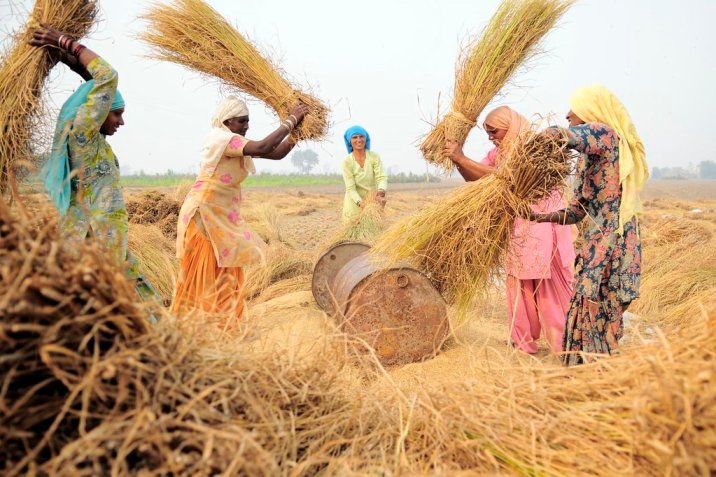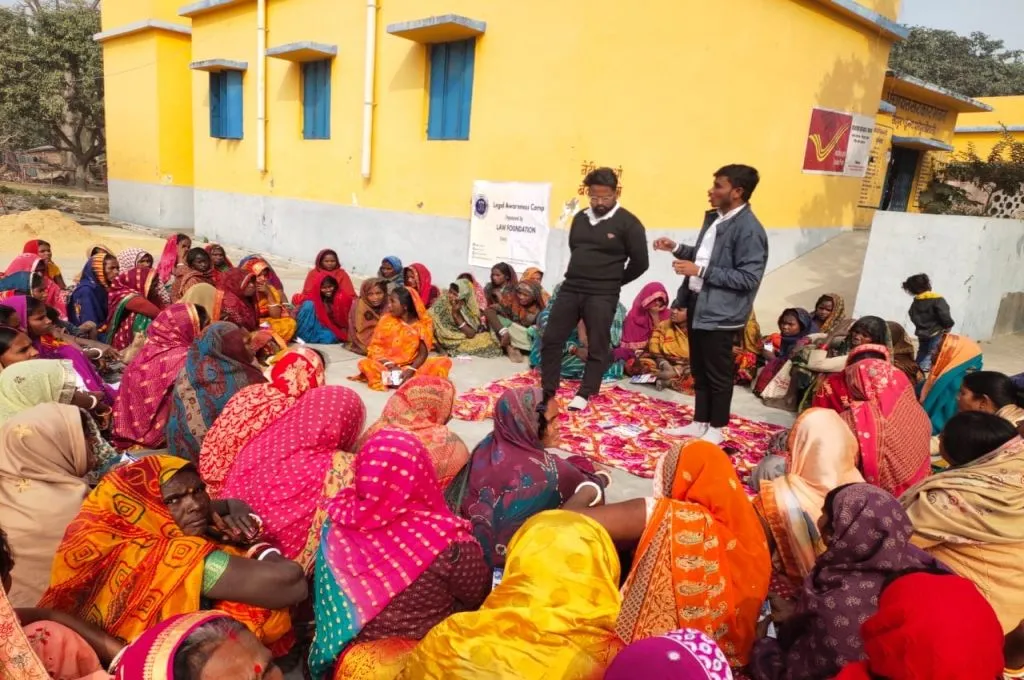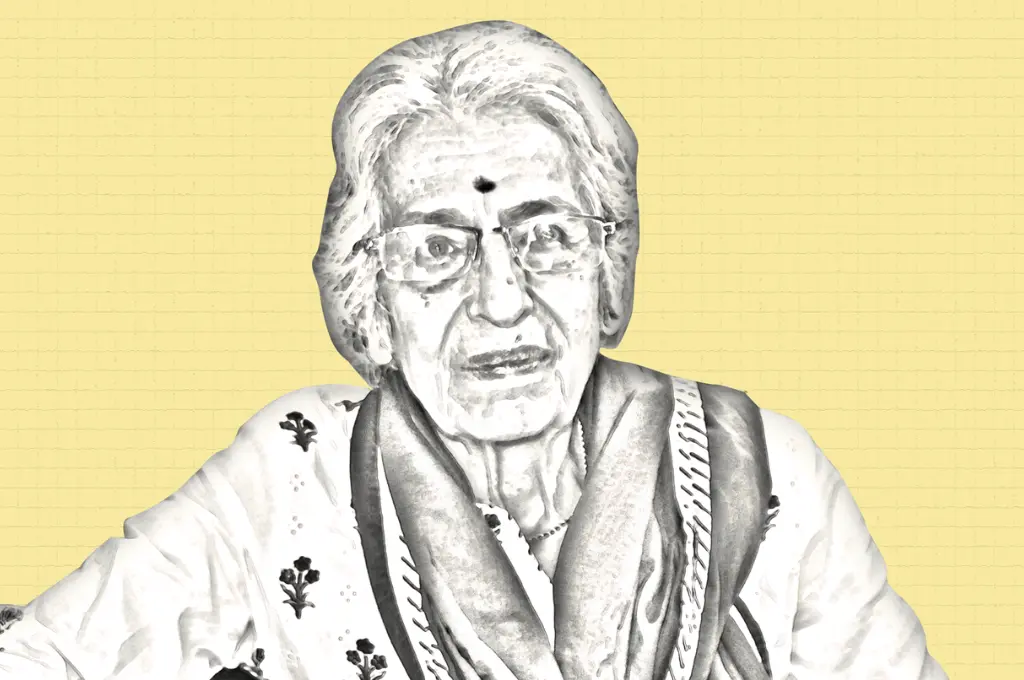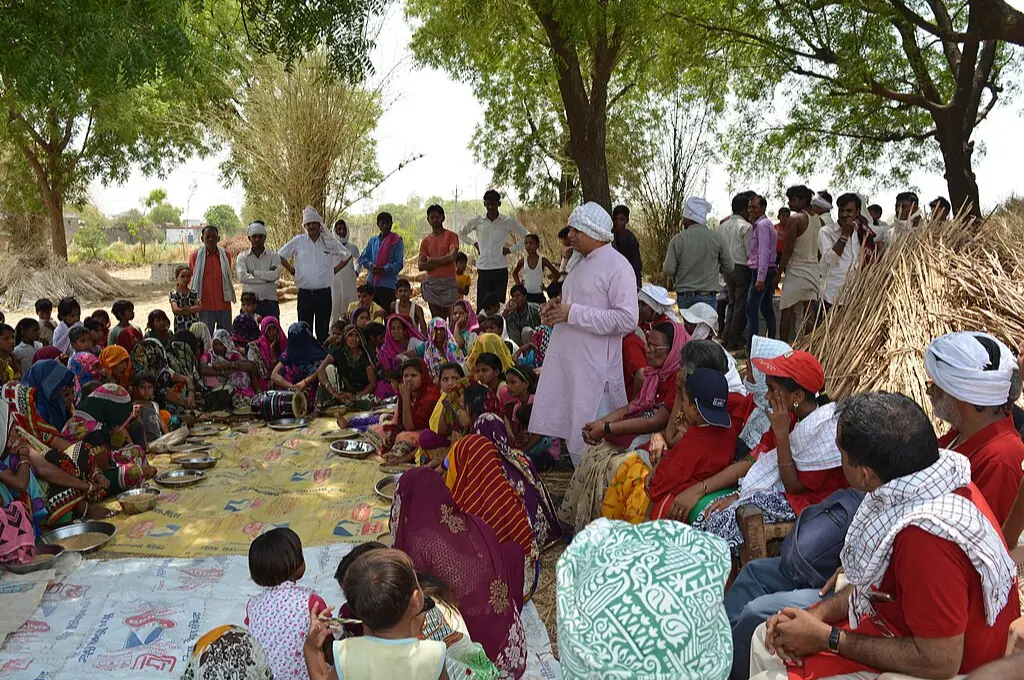“Our struggle is not just about money. It’s about owning a farm where we can go without fear,” said Paramjit Kaur, standing at the door of her kitchen, rolling a dough ball to make chapatis. “Now, our daughters can go alone to harvest fodder at any time.”
Paramjit Kaur was talking about the 15.5 acres of common land she is jointly tending with 200 other Dalit families of the village, earning 2.5 quintal wheat and Rs 1,200 annual profit per household.
At her home in Bhattiwal Kalan village of Sangrur district in Punjab, a green awning in the courtyard partly blocked the harsh summer sun. Around 50 metres away stood the family’s only reliable source of income—a cart full of cosmetics, small household items, and plastic toys. Paramjit Kaur’s husband, Major Singh, takes this mobile shop to neighbouring villages, earning around Rs 500 from daily sales. Her son recently joined a private firm in Sangrur as a laboratory assistant, relieving her of a job as a farm labourer.

Related article: Urbanising around tribal land
The family are among the several thousand Dalits participating in a land rights movement sweeping across 70 villages of southern Punjab, upsetting the deeply-entrenched power equations between upper-caste farmers and scheduled caste (SC) labourers.
The campaign also aims to protect village commons from encroachment, ensure food security, and uphold women’s safety. This is why the likes of Paramjit Kaur are at the forefront of this movement.
Land ownership and rights
In Punjab, upper castes, mostly Jat Sikhs, dominate the farming landscape. Only 3.5% of private farm land belongs to Dalits who make up 32% of the population, according to the Agriculture Census of 2015-16. The national average is 8.6% of farm land for 16.6% of Dalits.

Source: Agriculture Census 2015-16
Punjab has the maximum proportion (5.28%) of big farmers owning more than 10 hectares of land among all non-mountainous states of India. The national average is 0.57%, according to the Agriculture Census 2015-16.

Land consolidation is expected to grow further as modern, capital-intensive farming in the state benefits big farmers due to the economies of scale.
In the past, the only major land rights movement in Punjab was the Muzara Movement (1930-53), in which tenant farmers demanded the abolition of biswedari—a system in which landlords owned vast swathes of land—in the princely state of Patiala and East Punjab States’ Union (PEPSU). The agitation had led to violence against the protesting tenant farmers.
The Muzara Movement, however, did not include Dalits.
In 1961, the state passed the Punjab Village Common Lands (Regulation) Act, reserving 33% of agricultural village common land for SCs, who could get an annual lease through bidding (rules under the statute were framed in 1964). The implementation, however, was indifferent.
“Upper-caste farmers continued to cultivate this land by sponsoring proxy candidates from the reserved category, depriving the community of this right,” said Sucha Singh Gill of the Centre for Research in Rural and Industrial Development (CRRID), Chandigarh. “Dalits were also not vocal enough to challenge this arrangement.”
This transformation in Dalit assertiveness is, however, a work of decades.
“Even though we knew that the land is ours, we could not claim it,” said Avtar Singh, 65, a resident of Niyamatpur village of Sangrur district, who spent most of his life working on lands of big farmers. “Many of us were unlettered, unorganised and scared of going against the landlords who were our only source of income, food and fodder,” he told IndiaSpend.
In 2009, the Zameen Prapti Sangharsh Committee (ZPSC, or ‘land rights struggle committee’), an informal left-wing organisation, decided to mobilise Dalits through village-level committees. The ZPSC favours collective bidding and cultivation of the reserved common lands by all Dalits in a village.
“Educated youth and women were most willing to challenge the status quo,” said Gurmukh Singh, Sangrur district secretary of ZPSC. “They realised that owning a piece of land would bring prestige and cut through the dominance of the upper castes.”
This transformation in Dalit assertiveness is, however, a work of decades, said Ronki Ram, professor of political science at Panjab University, Chandigarh. Starting from before Independence, political consciousness emerged through the work of B R Ambedkar and Bahujan Samaj Party founder Kanshi Ram, born in Punjab’s Rupnagar district, and religious consolidation through the Ad Dharm (Ravidasia). More recently, the most concerted and powerful of these politico-religious sects where Dalits have congregated has been the Dera Sacha Sauda. Such deras have given Dalits the confidence to organise for a movement for land rights, Ronki Ram said.
“The Green Revolution has reduced interdependence of farmers and labourers due to increased farm mechanisation. Dalits started going to nearby towns for work,” said Gian Singh, former professor of economics at Punjabi University, Patiala. For those still involved in farm work, however, dependence persists. Around 68% of agricultural labourers get loans from big farmers, mostly at high interest rates, according to a 2017 study, ‘Indebtedness among farmers and agricultural labourers in rural Punjab’.
Related article: Putting land rights on the government’s agenda
Blood on land
Dalits are waging similar battles to lay claim to promised lands across India, as IndiaSpend reported on June 7, 2019. Across 13 Indian states, there were 31 conflicts involving 92,000 Dalits fighting to claim land, according to Land Conflict Watch, a network of researchers that maps and collects data on land conflicts in India.
Assertion of land rights often leads to grave violence in Punjab where popular culture glamourises gun toting to gain possession of land.
With the widespread use of proxies of Jat Sikh farmers, Dalits have disrupted auctions in several villages over the last 10 years, threatening proxy candidates and even stopping influential farmers from tilling the reserved lands.
Such acts have often resulted in violent repercussions as in Jhaloor village, where 72-year-old Gurdev Kaur was killed and several other protesters grievously injured in a brutal attack by a group of big farmers and their supporters on October 5, 2016. The attackers are currently facing trial in court.
Ballad Kalan, a village with the largest common lands in the region—121 acres as per land records reviewed by IndiaSpend—also endured a cycle of clashes. A few upper-caste farmers had been cultivating the common land for a long time. “In 2014, the proxies for landlords were again bidding for the reserved land at very high rates. We tried to stall the auction but police lathi-charged and threw us into waiting vans,” recalled 63-year-old Harmer Kaur, who braved many blows. “Though women were released later, 41 of our men were kept behind bars for 59 days on several charges.”
The women were not cowed. They uprooted paddy saplings from a plot of reserved land allotted to a proxy of one of the Jat farmers, forcing the state administration and village panchayat to re-auction the land within six months. This was the first time that Dalits won the lease as a collective in Ballad Kalan. The cycle of protests and arrests continued for a couple of years before the current peace, fragile as it is, was achieved.

The ZPSC favours collective bidding and cultivation of the reserved common lands by all Dalits in a village. | Photo courtesy: ©2011CIAT/NeilPalmer on Flickr
“It was a stormy and painful journey but also the most rewarding. We would travel to surrounding villages to garner support and to also spread the movement,” said Manpreet Kaur, 48, a short, stout woman whose house became the war room of ZPSC during the struggle. “We got substantial support from many small farmers in our village. Only a few big landlords eyeing the common land were against us.”
The then District Development Panchayat Officer of Sangrur, Joginder Kumar, refused to comment on the incidents and told IndiaSpend that the matter had been resolved amicably during his tenure. Another senior officer requesting anonymity, however, termed ZPSC’s methods as coercive. “The open auctions held earlier were transparent but the leaders provoked people to protest against the system,” he told IndiaSpend. “Only a few have benefited from the new setup.”
Gill of CRRID disagreed: “The movement has definitely improved access to food and fodder for Dalit families besides enhancing self-esteem of women.”
A prominent farm union leader in Punjab claimed that ZPSC has created enmity between farmers and farm workers. “The movement is led by former Naxalites who are still looking for some sort of revolution by dividing the society,” he said, “History shows that Dalits can’t till the land because they lack expertise.”
Such opinions are older than the Punjab Village Common Lands (Regulation) Act of 1961, and were voiced during debates in the state legislative assembly on reserving 33% common land for Dalits, said Jatinder Singh, assistant professor of political science at Punjabi University, Patiala.
“Many MLAs opposed the new law claiming that this will impact agricultural production in the state since Dalits are incapable of farming,” Singh told IndiaSpend. “This thinking flies in the face of the fact that they have been farm workers for generations. The only missing attribute was confidence because of past oppressions. Now, they have gained that as well.”
So shall they reap
In 2014, each Dalit family of Ballad Kallan contributed Rs 11,000 for the lease money, the fruits of which they are still enjoying. Today, every family earns on average Rs 30,000 annually, including five quintal wheat grains, from the land, villagers told IndiaSpend. Seven quintal of dry fodder is also allocated to every household. The rest of the money from the 121-acre community land is spent on paying the annual lease of Rs 21,500 per acre besides labour and other input costs.
Sexual exploitation is one of the most critical threats for women labourers, most of whom are Dalits.
Remembering the time she had to walk miles to fetch a load of green fodder from the fringes of Jat-owned farms, Harmer Kaur is thankful that the common land is now with the Dalits. “Sometimes the land owner would chase us or make indecent comments,” she recalled.
Sexual exploitation is one of the most critical threats for women labourers, most of whom are Dalits, found a recent study, ‘Socio Economic Conditions and Political Participation of Rural Women Labourers in Punjab’. “More than 70% respondents kept quiet when asked about their experiences related to sexual exploitation. The reality can be inferred from this,” said lead researcher Gian Singh, the former economics professor from Punjabi University. “The social stigma related to the issue forces many to keep mum.”
Things have changed since the movement, Harmer Kaur said: “Now, we don’t need to worry much about safety. We can work on our own community land for a daily wage and also buy green fodder from there.”
Related article: Is having more women in agriculture a good thing?
Future of land rights
From questioning power, the landless are now trying to gain political power. Thirty of the ZPSC members contested panchayat elections held in December 2018 as independent candidates. At Tolewal village, where they won the seat of sarpanch and two panchayat members, the movement is moving to the next level.
On June 6, 2019, the gram sabha of Tolewal passed a resolution to grant a 33-year lease for the reserved village common land to Dalit families. They disrupted subsequent attempts to hold bidding for the land, resulting in clashes on July 1 that left 15 people injured.
“The aim of 33-year lease is to avoid the annual cycle of protests and uncertainty which takes a toll on our children,” said Harwant Kaur, one of the women leaders of the village. “The long-term lease will also help protect the land from encroachments.”
This 33-year lease has been controversial.
“Long-term lease of common land is allowed only for development projects by government or private firms,” said Malerkotla Block Development Officer Amandeep Kaur, adding that a 33-year lease could not be granted for farming.
“The Dalits aligned to ZPSC are seeking long-term lease on low rate which means village panchayat will suffer loss in revenue,” former sarpanch Bir Singh told IndiaSpend. “When there is no provision to grant 33-year lease, how can this be done? When refused, they resort to violence.”
In response, Gurmukh Singh, district secretary of ZPSC, asked: “If cow sheds can be given on long-term lease, I don’t see a reason why Dalits can’t get the land reserved for them for 33 years. Are they worse than cows?”
The fight is for dignity, not profit.
The Dalits of Balad Kalan are also aiming for a 33-year lease, fearing that a proposed industrial park in the region would subsume their common lands. “The proposal includes 40 hectares of village common land but it requires approval of the panchayat that we would never let happen,” said Manpreet Kaur.
The movement has greater goals to achieve, said Gurmukh Singh of ZPSC. “The possession of common land has instilled confidence among Dalits but it can’t be their main source of livelihood,” he said. “The real change will come with proper implementation of land ceiling law and redistribution of private land. Only then the landless will gain equal status.”
Under the Punjab Land Reforms Act, 1972, a family unit (husband, wife, and children) cannot own more than 17.5 acres of fertile agricultural land that has access to good irrigation facilities. However, a family can hold up to 32 acres if the land is barren and without irrigation facilities.
For the likes of Paramjit Kaur, however, the fight is for dignity, not profit.
This article was originally published on IndiaSpend, a data-driven, public-interest journalism nonprofit. Reporting for this story was supported by the NCore Impact Journalism Grant 2019.





